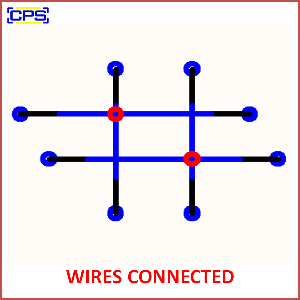Wires Connected refers to the arrangement or linking of multiple electrical wires to form a continuous path through which electric current can flow between components in a circuit. This connection enables electrical energy to be transferred or signals to be transmitted between devices, switches, power sources, or other electrical components.

Key Features of Wires Connected:
- Electrical Circuit Completion:
- Wires connected together form a complete electrical circuit. Without proper connections, current cannot flow, and devices or components in the circuit won’t function.
- Types of Connections:
- Series Connection: Wires are connected end-to-end in a single path, where current flows through each component in turn. The total resistance is the sum of individual resistances.
- Parallel Connection: Wires are connected in such a way that current can flow through multiple paths. This type of connection allows devices to operate independently, and the total resistance is reduced.
- Combination Connection: A mix of series and parallel connections to meet specific requirements in a circuit.
- Wire Soldering or Splicing:
- Wires are commonly connected using soldering (where wire ends are fused together with a melted metal alloy) or splicing (joining wires with connectors or twisting them together).
- Insulated vs. Uninsulated Connections:
- Connected wires are typically insulated to prevent accidental short circuits or electrical shocks. However, in some cases, uninsulated wires are used in controlled environments where insulation is not required.
Applications of Wires Connected:
- Power Distribution:
- Wires connected in series or parallel help transmit electrical power across a network, such as in homes, industries, or power grids.
- Circuit Design:
- In electronics, various components such as resistors, capacitors, and transistors are connected via wires to create functioning circuits in devices like computers, radios, and other electronics.
- Control Systems:
- Wires connected are used in control systems to relay signals from sensors, switches, or controllers to execute actions in machines or automated systems.
- Automotive Wiring:
- Wires are connected in vehicles to power systems like lighting, ignition, sensors, and entertainment systems.
Advantages of Proper Wire Connections:
- Reliable Power Flow:
- Properly connected wires ensure that electrical current flows smoothly to power devices, machinery, or equipment.
- Signal Integrity:
- In communication and electronics, connected wires allow clear and accurate transmission of signals without loss of data or quality.
- Safety:
- Correct connections with well-insulated wires prevent short circuits, electrical fires, or accidents due to exposed wires.
Disadvantages of Poorly Connected Wires:
- Inconsistent Power Delivery:
- Loose or incorrect wire connections can lead to unreliable power supply, causing devices to malfunction or not work at all.
- Electrical Hazards:
- Improperly connected wires can cause short circuits, sparks, or electrical fires if not securely insulated or correctly joined.
- Signal Loss or Distortion:
- Poor wire connections can lead to a loss in signal quality, especially in high-frequency applications, causing performance issues in devices like computers or communication systems.
